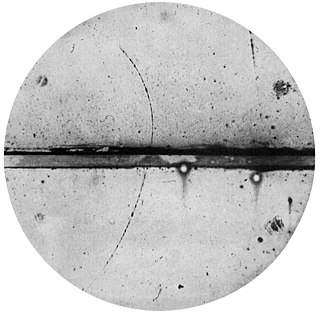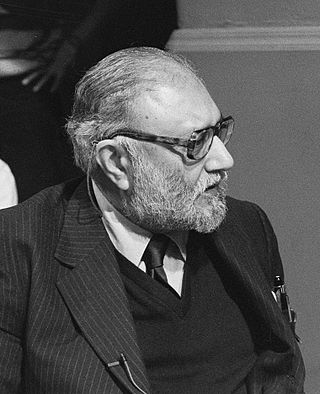Related Research Articles

In modern physics, antimatter is defined as matter composed of the antiparticles of the corresponding particles in "ordinary" matter, and can be thought of as matter with reversed charge, parity, and time, known as CPT reversal. Antimatter occurs in natural processes like cosmic ray collisions and some types of radioactive decay, but only a tiny fraction of these have successfully been bound together in experiments to form antiatoms. Minuscule numbers of antiparticles can be generated at particle accelerators; however, total artificial production has been only a few nanograms. No macroscopic amount of antimatter has ever been assembled due to the extreme cost and difficulty of production and handling.
Physics is the natural science of matter, involving the study of matter, its fundamental constituents, its motion and behavior through space and time, and the related entities of energy and force. Physics is one of the most fundamental scientific disciplines, with its main goal being to understand how the universe behaves. A scientist who specializes in the field of physics is called a physicist.

A supercluster is a large group of smaller galaxy clusters or galaxy groups; they are among the largest known structures in the universe. The Milky Way is part of the Local Group galaxy group, which in turn is part of the Virgo Supercluster, which is part of the Laniakea Supercluster. The large size and low density of superclusters means that they, unlike clusters, expand with the Hubble expansion. The number of superclusters in the observable universe is estimated to be 10 million.

The European Organization for Nuclear Research, known as CERN, is an intergovernmental organization that operates the largest particle physics laboratory in the world. Established in 1954, it is based in a northwestern suburb of Geneva, on the France–Switzerland border. It comprises 23 member states. Israel, admitted in 2013, is the only non-European full member. CERN is an official United Nations General Assembly observer.
The following is a timeline of galaxies, clusters of galaxies, and large-scale structure of the universe.

The Virgo Supercluster or the Local Supercluster is a mass concentration of galaxies containing the Virgo Cluster and Local Group, which itself contains the Milky Way and Andromeda galaxies, as well as others. At least 100 galaxy groups and clusters are located within its diameter of 33 megaparsecs. The Virgo SC is one of about 10 million superclusters in the observable universe and is in the Pisces–Cetus Supercluster Complex, a galaxy filament.

The Great Attractor is a purported gravitational attraction in intergalactic space and the apparent central gravitational point of the Laniakea Supercluster. This supercluster contains the Milky Way, as well as about 100,000 other galaxies.

Philae was a robotic European Space Agency lander that accompanied the Rosetta spacecraft until it separated to land on comet 67P/Churyumov–Gerasimenko, ten years and eight months after departing Earth. On 12 November 2014, Philae touched down on the comet, but it bounced when its anchoring harpoons failed to deploy and a thruster designed to hold the probe to the surface did not fire. After bouncing off the surface twice, Philae achieved the first-ever "soft" (nondestructive) landing on a comet nucleus, although the lander's final, uncontrolled touchdown left it in a non-optimal location and orientation.

The presence of women in science spans the earliest times of the history of science wherein they have made significant contributions. Historians with an interest in gender and science have researched the scientific endeavors and accomplishments of women, the barriers they have faced, and the strategies implemented to have their work peer-reviewed and accepted in major scientific journals and other publications. The historical, critical, and sociological study of these issues has become an academic discipline in its own right.

Knowledge of the location of Earth has been shaped by 400 years of telescopic observations, and has expanded radically since the start of the 20th century. Initially, Earth was believed to be the center of the Universe, which consisted only of those planets visible with the naked eye and an outlying sphere of fixed stars. After the acceptance of the heliocentric model in the 17th century, observations by William Herschel and others showed that the Sun lay within a vast, disc-shaped galaxy of stars. By the 20th century, observations of spiral nebulae revealed that the Milky Way galaxy was one of billions in an expanding universe, grouped into clusters and superclusters. By the end of the 20th century, the overall structure of the visible universe was becoming clearer, with superclusters forming into a vast web of filaments and voids. Superclusters, filaments and voids are the largest coherent structures in the Universe that we can observe. At still larger scales the Universe becomes homogeneous, meaning that all its parts have on average the same density, composition and structure.

Angela Saini is a British science journalist, broadcaster and the author of books, of which the fourth, The Patriarchs: The Origins of Inequality, was published in 2023. Saini has worked as a reporter and presenter for the BBC and has written for a number of publications including The Guardian, New Scientist, and Wired UK. She has also produced and presented several radio and television documentaries, including a BBC Radio 4 documentary on biofuels and a BBC World Service documentary on the impact of climate change on Indian agriculture. Saini's writing and reporting focus on how science interacts with society, especially on how it affects marginalized groups, and she has been acclaimed for her work by a diverse range of organizations and institutions.

Science and technology is a growing field in Pakistan and has played an important role in the country's development since its founding. Pakistan has a large pool of scientists, engineers, doctors, and technicians assuming an active role in science and technology. The real growth in science in Pakistan occurred after the establishment of the Higher education Commission in 2002 which supported science in a big way and also became the major sponsor of the Pakistan Academy of Sciences under the leadership of Prof. Atta-ur-Rahman. The emphasis was placed on quality rather than numbers during this period. The quality measures introduced by Prof. Atta-ur-Rahman as Founding Chairman HEC included:1) All Ph.D. thesis were evaluated by eminent foreign scientists,2) All PhD theses and research papers were checked for plagiarism 3) Some 11,000 students were sent abroad to leading universities for PhD level training and absorbed on their return, 4) Appointments at faculty positions were linked to international stature of the applicants as judged from their international publications, patents and citations, and (5) Quality Enhancement Cells were established in all universities for the first time in the history of the country. (6) The minimum criteria for establishment of a new university were approved by the Cabinet and universities that did not meet this criteria were closed down. (7) The Model University Ordinance was approved setting the governance parameters for new universities. (8) A list of fake higher education institutions was prepared and made public. (9) Quality Assurance Agency (QAA) was set up within the Higher Education Commission that established Quality Enhancement Cells (QECs) as its operational units in public and private-sector universities across the country. (10) The funding of universities was linked to excellence in teaching and research under a formula based funding mechanism that considered enrolment, subjects and quality of teaching and research. The first IT policy and implementation strategy was approved under the leadership of Prof. Atta-ur-Rahman, then Federal Minister of Science & technology, in August 2000 which laid the foundations of the development of this sector On the request of Prof. Atta-ur-Rahman, Intel initiated a nationwide programme to train school teachers in Information and Communication technologies in March 2002 which has led to the training of 220,000 school teachers in 70 districts and cities across Pakistan. A 15-year tax holiday was approved on the recommendation of Prof. Atta-ur-Rahman which has resulted in growth of IT business from $30 million in 2001 to over $3 billion. The Pakistan Austria University of Applied Engineering (Fachhochschule) has been established in Haripur Hazara under a Steering Committee Chaired by Prof. Atta-ur-Rahman in which students will get degrees from several Austrian universities. Pakistan's growth in scientific output can be seen from the fact that in 1990 Pakistan published 926 scholarly documents while in 2018 the number rose to 20548, a twenty times increase.In contrast India published 21443 scholarly documents in 1990 and the number rose to 171356 in 2018, an eight times increase. In 2018, 336 people per million were researchers in the R&D in Pakistan compared to 256 people per million being researchers in India. The reforms begun by Prof. Atta-ur-Rahman FRS in 2003-2008 have continued over the subsequent decade and according to the Web of Science report, there was a 300% growth in research publications in 2019 over the decade, with 2019 marking the first year in which Pakistan was ranked above the world average in research. In 2019, Pakistan produced 300% more publications indexed in the Web of Science Core Collection than in 2010. In the decade of 2010-2019, more than half of Pakistan’s research was published in journals with Impact Factor. The global influence of Pakistan’s research is increasing as scientists in the country are publishing more in top quartile journals. The Category Normalized Citation Impact of Pakistan’s publications has risen from 0.67 to 1.03. output. As of 2020, Pakistan has 85% teledensity with 183 million celllular, 98 million 3G/4G and 101 million broadband subscribers, due to the foundations laid by Prof. Atta-ur-Rahman of the IT and telecom industry during 2000-2008. In an analysis of scientific research productivity of Pakistan, in comparison to Brazil, Russia, India and China, Thomson Reuters has applauded the developments that have taken place as a result of the reforms introduced by Prof. Atta-ur-Rahman FRS, since Pakistan has emerged as the country with the highest increase in the percentage of highly cited papers in comparison to the "BRIC" countries

Fabiola Gianotti is an Italian experimental particle physicist who is the current and first woman Director-General at CERN in Switzerland. Her first mandate began on 1 January 2016 and ran for a period of five years. At its 195th Session in 2019, the CERN Council selected Gianotti for a second term as Director-General. Her second five-year term began on 1 January 2021 and goes on until 2025. This is the first time in CERN's history that a Director-General has been appointed for a full second term.
Michael John Pentz was a physicist, activist in the peace movement, and an influential pioneer of teaching science to university students by distance education. Pentz was born in Cape Town, South Africa, and died in France.

Sir Tejinder Singh Virdee,, is a Kenyan-born British experimental particle physicist and Professor of Physics at Imperial College London. He is best known for originating the concept of the Compact Muon Solenoid (CMS) with a few other colleagues and has been referred to as one of the 'founding fathers' of the project. CMS is a world-wide collaboration which started in 1991 and now has over 3500 participants from 45 countries.

Dame Pratibha Laxman Gai-Boyes is a British microscopist and Professor and Chair of Electron Microscopy and former Director at The York JEOL Nanocentre, Departments of Chemistry and Physics, University of York. She created the atomic-resolution environmental transmission electron microscope (ETEM) and is an outspoken advocate for women with careers in science.

The Laniakea Supercluster is the galaxy supercluster that is home to the Milky Way and approximately 100,000 other nearby galaxies. It was defined in September 2014, when a group of astronomers including R. Brent Tully of the University of Hawaiʻi, Hélène Courtois of the University of Lyon, Yehuda Hoffman of the Hebrew University of Jerusalem, and Daniel Pomarède of CEA Université Paris-Saclay published a new way of defining superclusters according to the relative velocities of galaxies. The new definition of the local supercluster subsumes the prior defined local supercluster, the Virgo Supercluster, as an appendage.

Hélène Courtois is a French astrophysicist specialising in cosmography. She is a professor at the University of Lyon 1 and has been a chevalier of the Ordre des Palmes Académiques since 2015.
Nature's 10 is an annual listicle of ten "people who mattered" in science, produced by the scientific journal Nature. Nominees have made a significant impact in science either for good or for bad. Reporters and editorial staff at Nature judge nominees to have had "a significant impact on the world, or their position in the world may have had an important impact on science". Short biographical profiles describe the people behind some of the year's most important discoveries and events. Alongside the ten, five "ones to watch" for the following year are also listed.
Daniel Pomarède is a staff scientist at the Institute of Research into the Fundamental Laws of the Universe, CEA Paris-Saclay University. He co-discovered Laniakea, a home supercluster of galaxies. Specialized in data visualization and cosmography, a branch of cosmology dedicated to mapping the Universe, he also co-authored the discoveries of the Dipole Repeller and of the Cold Spot Repeller, two large influential cosmic voids, and the discovery of the South Pole Wall, a large-scale structure located in the direction of the south celestial pole beyond the southern frontiers of Laniakea.
References
- ↑ Gibney, Elizabeth; Callaway, Ewen; Cyranoski, David; Gaind, Nisha; Tollefson, Jeff; Courtland, Rachel; Law, Yao-Hua; Maher, Brendan; Else, Holly; Castelvecchi, Davide (2018). "Ten people who mattered this year". Nature. 564 (7736): 325–335. doi: 10.1038/d41586-018-07683-5 . PMID 30563976.
- 1 2 "About the Editors | Nature". www.nature.com. Retrieved 2 March 2018.
- ↑ Barney, Dave. "OUTREACH". CERN Document Server.
- ↑ Meikle, James (14 November 2014). "Rosetta scientist Dr Matt Taylor apologises for 'offensive' shirt". The Guardian . Retrieved 2 March 2018.
- ↑ "Elizabeth Gibney". Times Higher Education (THE). 1 April 2015. Retrieved 2 March 2018.
- ↑ "Research Intelligence - Higgsteria: it's only the beginning". Times Higher Education (THE). 19 July 2012. Retrieved 2 March 2018.
- ↑ "Nature appoints Elizabeth Gibney as physics reporter - ResponseSource". ResponseSource. Retrieved 2 March 2018.
- ↑ nature video (28 February 2018), Signals from the cosmic dawn: A three minute guide , retrieved 2 March 2018
- ↑ Jasiek. "Jasiek | Landing on a comet". jasiek.co.uk. Retrieved 2 March 2018.
- ↑ nature video (3 September 2014), Laniakea: Our home supercluster , retrieved 2 March 2018
- ↑ Robins, Sallie. "Winners Announced in the 2015 Science Journalism Awards | News | News and Events | Association of British Science Writers (ABSW)". www.absw.org.uk. Retrieved 2 March 2018.
- ↑ "Stories by Elizabeth Gibney". Scientific American. Retrieved 2 March 2018.